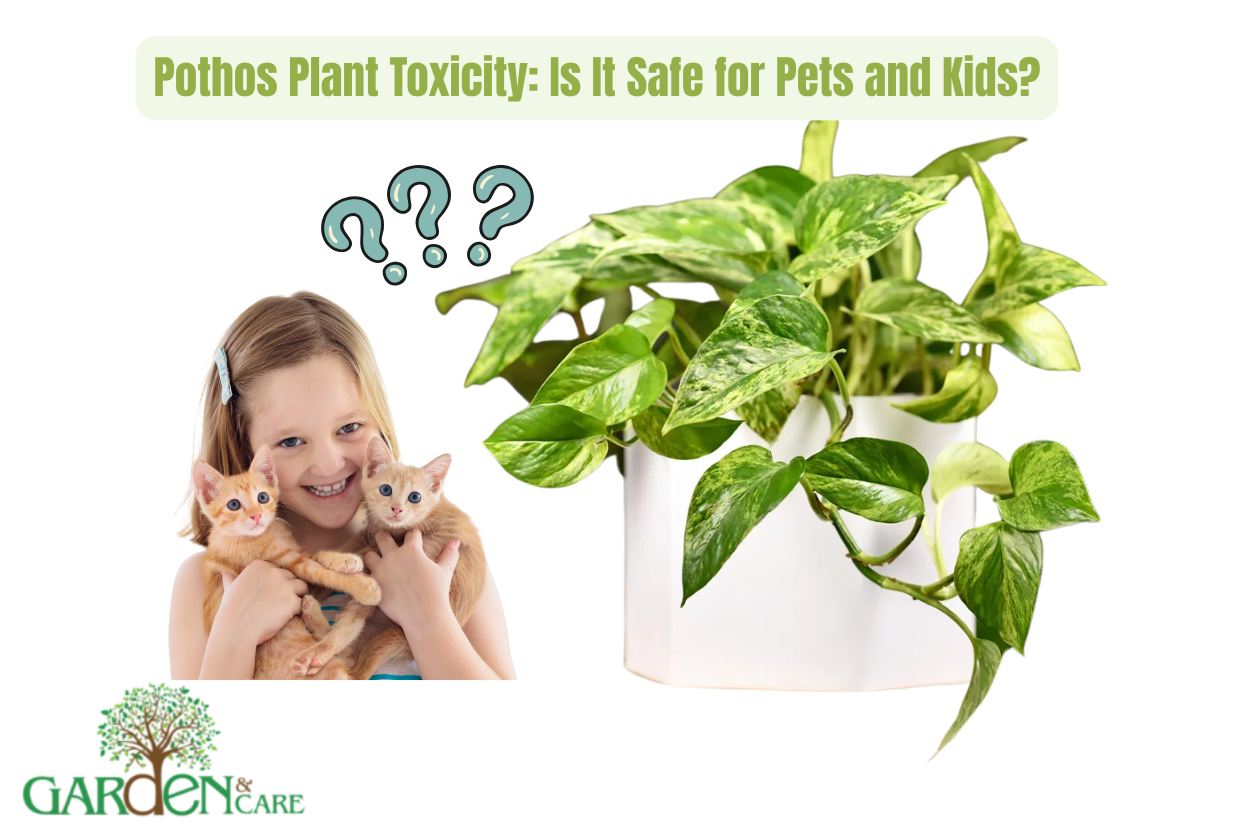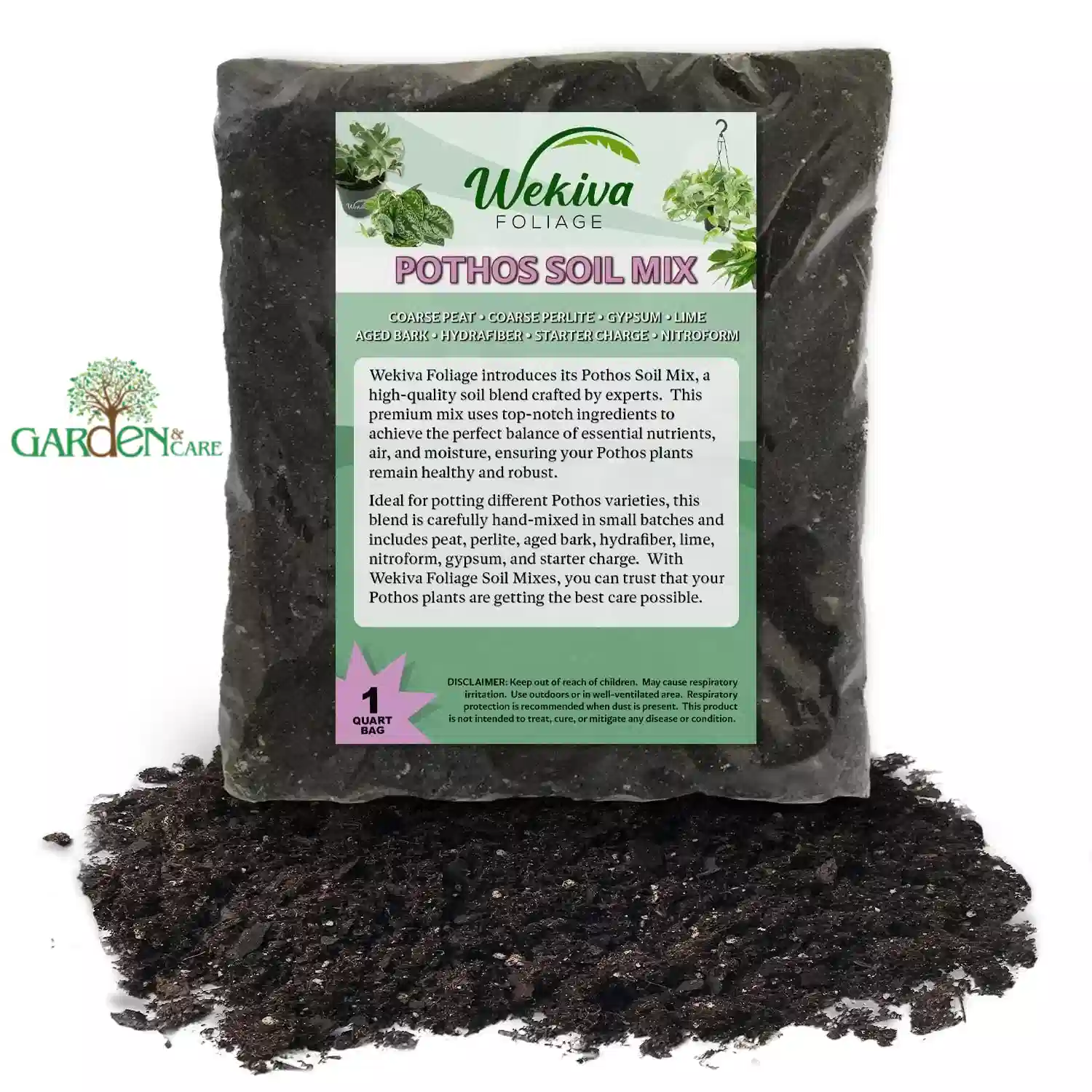Pothos plants are popular indoor favorites, but are they safe to keep around your pets and children? In this guide, we explore the truth about pothos Plant toxicity, signs of poisoning, and how to safely enjoy this plant in a home with curious kids and furry friends. Learn how to spot symptoms, prevent accidents, and choose safer alternatives if needed.
Introduction:
Pothos, also known as Devil’s Ivy, is one of the most beloved houseplants across the world. With its trailing vines, heart-shaped leaves, and hardy nature, it’s a favorite for both beginner plant parents and experienced indoor gardeners. Its ability to thrive in low light and minimal care requirements make it an ideal choice for homes, offices, and apartments.
But while pothos might be easy to grow, there’s a question many parents and pet owners need to ask before bringing one home: Is pothos safe for my family?
If you have curious cats, playful dogs, or small children who love exploring with their hands—and mouths—it’s essential to understand which plants can pose risks. Although indoor greenery brings life and beauty to your home, some plants, like pothos, come with a caution tag when it comes to toxicity.
So, let’s address the concern directly: Yes, pothos is toxic to pets and children if ingested. However, this doesn’t mean you need to give up your love for this stunning plant entirely. With the right knowledge and a few simple precautions, you can still enjoy pothos in your home safely.
In this post, we’ll walk you through:
- What makes pothos toxic
- The symptoms of poisoning in pets and children
- How to prevent accidents
- Safer ways to enjoy pothos (or choose alternatives)
Whether you’re a pet parent, a new mom, or just someone who wants to keep their home safe and green, this guide will give you everything you need to know.
🌱 What Makes Pothos Plant Toxicity?
While pothos plants are beautiful and easy to care for, they contain a hidden danger that’s important to understand—calcium oxalate crystals.
🌟 What Are Calcium Oxalate Crystals?
These tiny, sharp crystals are naturally found in the leaves and stems of the pothos plant. They’re microscopic, but they act like tiny needles. When chewed or ingested, these crystals embed themselves into the soft tissues of the mouth, throat, and digestive tract, causing immediate irritation.
Think of it like tiny glass shards—unseen but extremely painful. This is what makes pothos toxic.
🐾 How Pothos Affects Pets (Especially Cats and Dogs)
Pets, especially curious cats and playful dogs, are often tempted to nibble on houseplants. Unfortunately, even a small bite of a pothos leaf can lead to noticeable discomfort. Here’s what can happen if your pet chews on pothos:
- Oral irritation: Drooling, pawing at the mouth, and whining are common.
- Swelling: The tongue, lips, and mouth may swell, making it hard for your pet to eat or swallow.
- Vomiting and nausea: Ingesting larger amounts can upset your pet’s stomach and lead to vomiting.
- Lethargy: Your pet may seem unusually tired or sluggish after exposure.
In rare and extreme cases—especially if a large quantity is consumed—more serious complications like difficulty breathing could occur. While pothos toxicity isn’t usually fatal, it’s painful and distressing for pets.
👶 Are Toddlers and Babies at Risk?
Yes. Small children are naturally curious and love to explore with their hands and mouths. If a toddler puts a pothos leaf in their mouth, they’ll experience symptoms similar to those in pets:
- A burning sensation in the mouth or throat
- Excessive drooling or crying
- Swelling of lips or tongue
- Possible difficulty swallowing
Thankfully, most children will spit out the leaf quickly because of the intense discomfort. However, even brief exposure can cause irritation, and in any suspected case, medical attention is recommended.
The toxic compound in pothos—calcium oxalate crystals—can cause real pain and discomfort in both pets and children. But understanding how it works is the first step in preventing accidents. In the next section, we’ll explore how to recognize the symptoms of exposure and what to do if your child or pet comes in contact with the plant.
🐶🐱 Signs of Pothos Poisoning in Pets
If your furry friend has gotten a little too curious and chewed on your pothos plant, you may start to notice some concerning symptoms. While pothos poisoning is rarely fatal, it can be quite painful and distressing for your pet. Recognizing the early warning signs is key to getting them the care they need.
🚨 Common Symptoms in Cats and Dogs
Pets react quickly to the sharp calcium oxalate crystals found in pothos leaves and stems. These crystals embed in the soft tissues of the mouth and throat, causing almost immediate irritation. Here’s what to look out for:
- 😖 Mouth/Tongue Irritation and Swelling
One of the first signs is visible discomfort in the mouth area. Pets may paw at their face or rub it against furniture in an effort to relieve the burning sensation. Swelling in the lips, tongue, or even the throat may follow. - 🤢 Vomiting and Drooling
Due to the mouth irritation or ingesting part of the plant, your pet might start drooling excessively. Vomiting may occur shortly afterward, especially in dogs or if a larger piece of the plant is swallowed. - 😿 Scratching or Itching Around the Face
Cats are particularly prone to excessive scratching around the mouth and face. This is usually an instinctive reaction to the intense irritation caused by the crystals. Dogs may also rub their face along the ground or paw aggressively at their muzzle. - 🍽️ Loss of Appetite
Your pet may avoid eating for several hours, sometimes even longer. This is typically due to the pain or discomfort in the mouth or throat after contact with the plant.
⏱️ When Do Symptoms Appear?
Most symptoms appear within 10 to 30 minutes after your pet bites or chews the plant. In some cases, vomiting or drooling can start even sooner. It’s a rapid reaction that doesn’t usually go unnoticed.
If your pet is showing multiple symptoms—or if you’re unsure what they might have eaten—it’s best to contact your vet immediately. In rare cases, the swelling can interfere with breathing, making quick response essential.
Quick Tip:
If you suspect pothos poisoning, don’t try to induce vomiting at home without veterinary advice. Instead, rinse your pet’s mouth gently with water and call your vet for further instructions.
👶 Is Pothos Toxic to Kids?
While pothos is a beautiful and easy-to-care-for houseplant, it’s important for parents and caregivers to know that it can pose risks to young children—especially those in the crawling, teething, and exploring stages. The good news? With a little awareness and smart placement, you can enjoy your pothos while keeping your little ones safe.
⚠️ Can Touching or Chewing Pothos Harm Children?
Yes, chewing or ingesting pothos can be harmful to children. Like with pets, the danger comes from calcium oxalate crystals found in the plant’s leaves and stems. These microscopic crystals are sharp and can cause immediate irritation if a child chews or bites the plant.
Touching pothos leaves is generally not dangerous unless a child rubs their eyes or puts their fingers in their mouth afterward. In that case, mild skin or eye irritation may occur.
🩺 Symptoms to Watch for if a Child Chews Pothos
If a child bites or chews a pothos leaf, you might notice:
- Mouth or lip irritation
Burning sensation, redness, or swelling in the lips, tongue, or mouth. - Drooling
Increased saliva production as a reaction to the irritation. - Crying or discomfort
Children may cry or pull at their mouth due to the sharp pain. - Difficulty swallowing or speaking
In more severe reactions, swelling might affect speech or swallowing.
🚨 What to Do If a Child Ingests Part of the Plant
If you suspect your child has chewed on or swallowed pothos, here’s what you should do:
- Stay calm
Most cases are not life-threatening but do require attention. - Rinse the mouth
Use clean, cool water to gently rinse the child’s mouth to remove any plant residue. - Offer something cold
Giving a cold drink or ice chips (if age-appropriate) may help soothe the mouth. - Watch for symptoms
Monitor for swelling, drooling, vomiting, or breathing difficulty. - Call your doctor or Poison Control
In the U.S., the Poison Control Center can be reached at 1-800-222-1222. Follow their advice carefully.
Note: If your child is having trouble breathing or you see swelling in the throat or tongue, seek emergency medical help immediately.
🏡 Safety Tips: How to Keep Pothos in a Pet & Kid-Friendly Home
Just because pothos is toxic doesn’t mean you have to give it up! With a few smart precautions, you can still enjoy the beauty of this low-maintenance plant without putting your pets or kids at risk. Here are practical tips to help you safely keep pothos in your home:
🌿 1. Keep Plants Out of Reach
The most effective safety measure is placing your pothos where little hands and paws can’t reach:
- Use hanging planters: Install them high enough that cats can’t jump to them and toddlers can’t tug on them.
- Utilize high shelves: Place pothos on bookshelves or tall cabinets that aren’t easily accessible.
- Wall-mounted pots: Consider vertical plant setups that keep your greenery off the floor and out of reach.
Tip: Observe your pet’s climbing ability—especially cats. What seems “out of reach” to you might be easily reachable to them!
🛡️ 2. Use Pet Deterrent Sprays
If you have persistent pets who love to nibble on plants, natural deterrents can help:
- Citrus sprays: Cats and some dogs dislike the scent of citrus. A homemade lemon or orange spray (diluted) can discourage chewing.
- Commercial sprays: Products like bitter apple or pet-safe plant sprays are available in pet stores. They create an unpleasant taste or smell.
- Reapply regularly: These sprays wear off over time, especially after watering, so reapply every 1–2 weeks.
👶 3. Teach Kids About “No-Touch” Plants
For toddlers and older children, early education goes a long way:
- Introduce plant rules: Teach them that some houseplants are just for looking, not touching or tasting.
- Use visual reminders: Small signs or color markers near toxic plants can help reinforce the message.
- Model good behavior: Show kids how to admire plants with their eyes, not their hands or mouths.
👁️ 4. Supervise Babies and Toddlers
Children under 3 are especially curious and tend to explore the world with their mouths. Keep a close eye on:
- Play areas: Avoid placing plants near floors, low shelves, or windowsills where babies crawl or play.
- Exploration time: If your child is walking or climbing, be extra cautious about furniture near plant zones.
Safety Tip: During playtime, create a plant-free zone for worry-free supervision.
🚨 What to Do If Your Pet or Child Ingests Pothos
Accidents can happen in even the most carefully monitored homes. If your pet or child ingests part of a pothos plant, don’t panic—but do act quickly and calmly. Here’s what you need to know:
🧘♀️ First Steps: Stay Calm and Assess Symptoms
Panicking can make the situation more stressful for both you and the affected pet or child. Instead:
- Remove any remaining plant material from their mouth gently and carefully.
- Check for visible symptoms, such as:
- Excessive drooling
- Pawing or rubbing at the mouth
- Redness, swelling, or irritation
- Vomiting or gagging
- Refusal to eat or drink
- Excessive drooling
- Try to determine how much was ingested (a bite, a few leaves, or more).
💡 Pro Tip: Take a photo of the plant to show your vet or poison control—it helps with faster identification and treatment.
📞 When to Call the Vet or Poison Control
Once you’ve assessed the situation, reach out for professional advice immediately:
- For pets: Contact your veterinarian or an emergency animal poison control center (such as ASPCA Animal Poison Control at 1-888-426-4435 in the U.S.).
- For children: Call your country’s poison control hotline (in the U.S., it’s 1-800-222-1222) or your pediatrician.
- Share important info:
- Age/weight of your pet or child
- How much they ate
- What symptoms are present
- Age/weight of your pet or child
⚠️ Important: Even if symptoms seem mild, it’s best to err on the side of caution—calcium oxalate can cause throat swelling or airway issues if untreated.
🩹 Emergency Home Care Tips While You Wait
If you can’t reach help right away or are waiting for assistance:
- Rinse the mouth gently with cool, clean water to ease irritation.
- Offer a small amount of milk or yogurt to pets if your vet recommends it (it may help soothe the burning sensation from calcium oxalate crystals).
- Keep your child or pet calm and still to avoid further irritation or swallowing more plant matter.
- Do NOT induce vomiting unless instructed by a medical professional—it can make symptoms worse.
⏱️ Time matters. The faster you act, the better the chance of avoiding complications.
While pothos ingestion rarely results in fatal poisoning, it can cause serious discomfort or distress. Prompt action and professional advice can make all the difference in ensuring your loved one recovers safely.
🌱 Safe Alternatives to Pothos
If you love the look of pothos but want a worry-free option for a home with pets or small children, the good news is—you have plenty of beautiful, non-toxic alternatives. These plants can offer similar trailing or leafy aesthetics without the risk of poisoning.
🪴 Non-Toxic Lookalike Houseplants
Here are some safe and stylish pothos alternatives you can confidently bring into your home:
✅ Spider Plant (Chlorophytum comosum)
- Known for its long, arching green and white striped leaves
- Easy to grow and air-purifying
- Totally safe for cats, dogs, and kids
- Fun fact: Some pets may chew on them, but it won’t hurt them
✅ Prayer Plant (Maranta leuconeura)
- Vibrant, patterned leaves that “fold” up at night
- Compact and decorative—perfect for tabletops or shelves
- Safe for both children and animals
- Thrives in moderate light and humidity
✅ Calathea (All Calathea varieties)
- Gorgeous tropical foliage with striking patterns
- Similar lush appeal as pothos
- Completely non-toxic to pets and kids
- Needs more humidity but rewards you with bold beauty
✅ Peperomia
- Compact, slow-growing, and comes in many textures and colors
- Safe to the touch and if nibbled
- Ideal for desks, windowsills, or small spaces
✅ Areca Palm (Dypsis lutescens)
- Adds a tropical vibe and can grow tall indoors
- Completely pet- and kid-safe
- Low-maintenance and acts as a natural humidifier
🌿 Tips for Choosing Pet- and Kid-Safe Greenery
Here are a few pointers when selecting safe plants:
- Check toxicity status before bringing any new plant home. Use reliable sources like the ASPCA plant list.
- Go for hanging or elevated planters even with non-toxic varieties to avoid mess or overhandling.
- Keep labels and care cards so you can always reference the plant’s safety and needs.
- Involve kids in caring for plants—they’re less likely to chew or touch what they help grow and understand.
You don’t have to sacrifice beauty for safety. With the right choices, your home can stay lush and lively without compromising the wellbeing of your pets or little ones. Choose plants that bring peace of mind along with greenery!
❓ FAQs: Your Pothos Plant Safety Questions Answered
1. Can pothos cause death in pets?
While rare, severe pothos poisoning can be fatal if a pet consumes a large amount and doesn’t receive treatment. The calcium oxalate crystals in the plant can cause intense mouth and throat irritation, leading to swelling, vomiting, or even breathing difficulties. Always contact your vet immediately if you suspect ingestion.
2. Is pothos safe in bedrooms or nurseries?
It’s not recommended to keep pothos in spaces where pets or toddlers freely roam, like bedrooms or nurseries. If you do want to keep it there, ensure it’s in a high, out-of-reach location such as a hanging basket or a secured wall shelf—well beyond reach of curious hands or paws.
3. How toxic is pothos compared to other houseplants?
Pothos is considered moderately toxic. It won’t usually cause life-threatening issues unless ingested in large amounts, but the symptoms can be painful and alarming. Compared to highly toxic plants like lilies (deadly to cats) or dieffenbachia (causes extreme oral swelling), pothos is less dangerous but still not fully safe.
4. Can touching pothos leaves cause skin irritation?
In most cases, touching pothos leaves is safe for adults and children. However, some people—especially those with sensitive skin or plant allergies—may experience mild skin irritation or itching due to the plant’s sap. It’s best to wash your hands after handling pothos, especially before eating or touching your face.
🌿 Conclusion: Pothos and Safety Can Coexist
Pothos may be mildly toxic to pets and young children, but that doesn’t mean you have to give up your love for indoor greenery. With a little extra care—like keeping your plants out of reach, using deterrents, and staying informed about symptoms—you can enjoy the beauty of pothos without putting your family at risk.
Living with pets and kids doesn’t mean sacrificing your plant collection. It simply means choosing smart solutions and staying prepared.
Whether you decide to keep pothos or switch to non-toxic alternatives, take these simple precautions to create a safe, beautiful, and worry-free green space in your home.
Check out this Content also-Best Soil Mix for Healthy and Fast-Growing Pothos





Leave a Reply